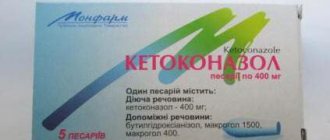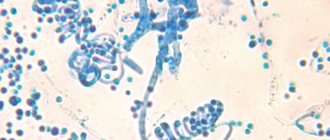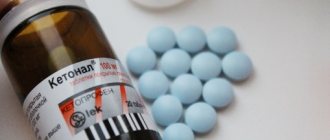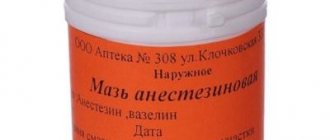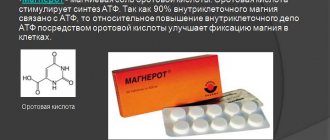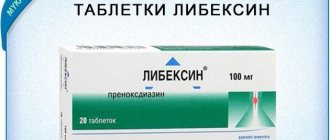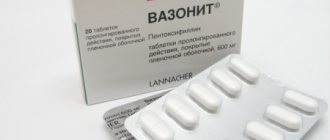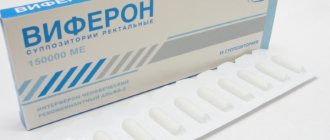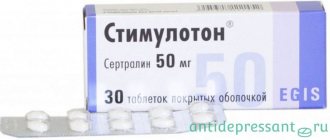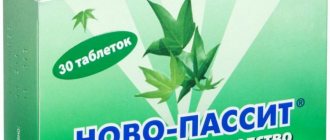Compound
- 1 gram of Ketoconazole cream contains 200 mg of the drug of the same name. Additional substances: labrafil M, emulsir 61, nipagin, vaseline oil, water.
- One Ketoconazole suppository contains 200 mg of the drug of the same name. Additional substances: semi-synthetic glycerides (up to a total mass of the candle of 2000 mg), butylated hydroxyanisole.
- One tablet of the drug Ketoconazole contains 200 mg of the drug of the same name. Additional substances: lactose, corn starch, magnesium stearate, silicon dioxide, low molecular weight PVP.
pharmachologic effect
Manufacturer: VERTEKS JSC (Russia)
Release form: tablets, capsules, suppositories, shampoo, cream for external use
Active ingredient: ketoconazole
Analogues: Terbinafine, Nizoral, Itraconazole
Ketoconazole is a synthetic drug directed against the action of a number of fungi. The active substance included in the drug changes the lipid composition of the fungal membrane, which leads to a disruption of the permeability of the wall in the cellular structure of the pathogen.
Release form
- Homogeneous white cream with a yellowish tint. 10, 15 or 25 grams of cream in an aluminum tube, one tube in a pack of paper.
- White, cylindrical vaginal suppositories with a yellowish tint; the presence of an air rod or a funnel-shaped depression is allowed on the cut. 5 candles in a contour package, 1 cell package in a paper pack.
- White round tablets with a yellowish tint, with a cross-shaped notch on one side. 10 tablets in a blister, 1 or 2 blisters in a paper pack.
In what cases is it prohibited to use the drug?
The instructions say that it is not recommended to use the drug:
- for acute and chronic kidney diseases;
- during lactation and pregnancy (strictly according to doctor’s recommendations);
- if there is a dysfunction of the pituitary gland;
- with hypersensitivity to one of the components of the drug;
- It is not recommended to combine with sleeping pills.
Must be stored out of the reach of children. Candles should be stored for 2 years in a cool place.
Pharmacodynamics and pharmacokinetics
Pharmacodynamics
Ketoconazole is a man-made imidazole . Has fungistatic and fungicidal effects. It inhibits the biosynthesis of ergosterol and disrupts the normal lipid composition of the cell wall of fungi.
It acts on Epidermophyton floccosum, dermatophytes of the genera Microsporum, Trichophyton, as well as fungi of the genus Pityrosporum and Candida.
Pharmacokinetics of the cream
When applied locally, the active substance is practically not subject to systemic absorption; with prolonged use, its content in the blood is not determined.
Pharmacokinetics of suppositories
Absorption into the systemic circulation when administered intravaginally is extremely low.
Pharmacokinetics of tablets
The bioavailability of ketoconazole reaches its greatest values when consumed with food. If this condition is met, the maximum content of the drug in the blood is achieved after 1-2 hours. Absorption of the active substance is reduced in persons with reduced acidity of gastric juice and achlorhydria .
Reaction with blood proteins reaches 99%. Widely distributed in organs and tissues, except for the cerebrospinal fluid. Metabolized in the liver with the release of a large number of inactive derivatives. The main biotransformation pathways are aromatic hydroxylation, cleavage and oxidation of piperazine and imidazole rings, and oxidative O-dealkylation . The half-life is approximately 10 hours.
It is excreted mainly in bile and feces.
Pharmacological properties of the drug Ketoconazole
Ketoconazole is a synthetic derivative of imidazoledioxolane. It has a fungicidal and fungistatic effect against dermatophytes, yeasts (genera Candida , Pityrosporum , Torulopsis , Cryptococcus ), dimorphic and higher fungi (eumycetes). Less sensitive to ketoconazole are Aspergillus spp ., Sporothrix schenckii , some Dermatiaceae , Mucor spp . and other fucomycetes, with the exception of Entomophthrales . Pharmacological properties are due to the ability to have a damaging effect on the cell membrane of fungi. By interacting with the enzyme 14-α demethylase, ketoconazole inhibits the biosynthesis of ergosterol, an essential membrane component, from lanosterol. Like other azole compounds, the mechanisms of antifungal action of ketoconazole include inhibition of cellular respiration processes, interaction with membrane phospholipids, disruption of the transformation of yeast fungi into filamentous forms, suppression of purine uptake, disruption of the biosynthesis of triglycerides and/or phospholipids. At high concentrations, ketoconazole can have a direct physicochemical effect on fungal membranes, exhibiting a fungicidal effect. Secondary resistance to ketoconazole does not develop. In the acidic environment of the stomach, it quickly dissolves to form hydrochloride, which is quickly absorbed. The bioavailability of ketoconazaole depends on the acid-producing function of the stomach. Coadministration with food may increase the absorption of ketoconazole. The maximum concentration in blood plasma is achieved 1–4 hours after oral administration. Widely distributed in most body fluids. Binding to blood plasma proteins is 84–99%, mainly with albumin. Elimination from blood plasma is biphasic. The half-life in the first phase is about 2 hours, in the terminal phase - about 8 hours. Partially metabolized by oxidation, dealkylation and aromatic hydroxylation. Most of ketoconazole and its metabolites are excreted in the bile and then excreted in the feces (57% within 4 days, of which 20–65% unchanged), the remainder is excreted in the urine (13% within 4 days, of which 2–4 % unchanged). When used externally, it is not subject to significant resorption. Systematic topical application in the form of 2% shampoo leads to the accumulation of ketoconazole in the hair keratin. When administered intravaginally, small amounts of ketoconazole enter the systemic circulation. The maximum plasma concentration in women after intravaginal use of 400 mg of ketoconazole ranges from 0–20.7 ng/ml.
Indications for use
Indications for use of Ketoconazole cream
- athlete's foot inguinal ;
- dermatomycosis of smooth skin;
- athlete's foot and hands;
- pityriasis versicolor;
- candidiasis ;
- seborrheic dermatitis caused by Pityrosporum ovale.
Indications for the use of Ketoconazole suppositories
- Treatment of vaginal recurrent candidiasis , both acute and chronic.
- Prevention of the development of fungal infections of the vagina with reduced protective function of the body and during therapy with antibacterial agents and other drugs that alter the normal microflora.
Indications for the use of Ketoconazole tablets
- Therapy and prevention of mycoses provoked by drug-sensitive microorganisms: infectious lesions of the mucous membranes of the digestive tract; severe lesions of the skin, nails and hair ( onychomycosis , dermatophytosis , pityriasis versicolor and others); vaginal recurrent candidiasis of a chronic nature with ineffective local treatment; systemic mycoses ( paracoccidioidomycosis, candidiasis, coccidioidomycosis, histoplasmosis, blastomycosis ).
- Prevention of fungal infections in weakened patients, including those suffering from immunodeficiency .
Instructions:
Clinical and pharmacological groups
09.005 (Antifungal drug for topical use) 29.065 (Drug with antifungal and antiproliferative action for external use) 09.001 (Antifungal drug) 09.004 (Antifungal drug for external use)
pharmachologic effect
Antifungal agent. It has fungicidal and fungistatic effects. The mechanism of action is to inhibit the synthesis of ergosterol and change the lipid composition of the membrane. It is active against the causative agent of pityriasis versicolor Malassezia furfur, causative agents of some dermatomycosis (Trichophyton, Epidermophyton floccosum, Microsporum), causative agents of candidiasis (Candida), as well as causative agents of systemic mycoses (Cryptococcus).
Also active against gram-positive cocci: Staphylococcus spp., Streptococcus spp.
Dosage
For oral administration to adults and children weighing more than 30 kg - 200-400 mg/day. Children weighing less than 30 kg - 4-8 mg/kg/day. Take 1 time/day with meals.
For external and local use, the dosage regimen depends on the indications and dosage form used.
Drug interactions
With simultaneous use of ketoconazole with rifampicin and isoniazid, a decrease in the concentration of ketoconazole in the blood plasma is observed.
With simultaneous use of ketoconazole with cyclosporine, indirect anticoagulants and methylprednisolone, their concentrations in the blood plasma may increase.
Use during pregnancy and lactation
Contraindicated for use during pregnancy and lactation.
Side effects
From the digestive system: in rare cases - nausea, vomiting, diarrhea.
From the central nervous system and peripheral nervous system: in rare cases - headache, dizziness, sleep disorders, paresthesia.
Dermatological reactions: in rare cases, exanthema; very rarely - hair loss.
From the reproductive system: very rarely - gynecomastia, decreased libido, oligospermia.
Allergic reactions: very rarely - urticaria, skin rash.
Other: in rare cases - photophobia, thrombocytopenia; very rarely - arthralgia, fever.
Indications
Fungal infections of the gastrointestinal tract, genitals, skin, hair (including seborrheic dermatitis), nails caused by sensitive pathogens. Systemic mycoses. Prevention of fungal infections in patients at increased risk of developing them.
Contraindications
Severe liver and kidney dysfunction, pregnancy, lactation, hypersensitivity to ketoconazole.
special instructions
When administered orally, it is necessary to regularly monitor the peripheral blood picture, the functional state of the liver and kidneys. If GCS was used to treat skin lesions, then ketoconazole should be prescribed no earlier than 2 weeks later.
Preparations containing KETOCONAZOLE
• KETOCONAZOLE-ALTFARM ◊ vaginal suppositories. 400 mg: 5 pcs. • SEBOZOLE ◊ ointment for external use. approx. 2%: tube 15, 30 or 50 g • NIZORAL® tab. 200 mg: 10 or 30 pcs. • ORONAZOL ◊ tab. 200 mg: 20 pcs. • FUNGINOK ◊ tab. 200 mg: 2, 10, 30 or 100 pcs. • LIVAROL® (LIVAROLE) ◊ vaginal suppositories. 400 mg: 5 or 10 pcs. • MYCOKET® ◊ ointment for external use. approx. 2%: tube 15 g • KETO PLUS ◊ shampoo 20 mg + 10 mg/1 g: fl. 60 ml • MYCOSORAL® tab. 200 mg: 10, 20 or 30 pcs. • SEBOZOL ◊ shampoo 20 mg/ml: vial. 100 ml • MYCOSORAL® ◊ ointment for external use. approx. 2%: tube 15 g • KETOCONAZOLE-ALTFARM ◊ vaginal suppositories. 200 mg: 5 pcs. • FUNGISTAB ◊ tab. 200 mg: 30 pcs. • NIZORAL ◊ shampoo 2%: fl. 25 ml or 60 ml • PERKHOTAL ◊ shampoo 1%: fl. 25, 60, 100, 150, 200 or 250 ml, 5 ml sachets. • PERKHOTAL ◊ ointment for external use. approx. 2%: tube 15 g • NIZORAL ◊ cream for external use. approx. 2%: tube 15 g • KETOCONAZOLE ◊ tab. 200 mg: 30 pcs. • MYCOSORAL® ◊ shampoo 2%: fl. 60 g • PERKHOTAL ◊ shampoo 2%: fl. 25, 60, 100, 150, 200 or 250 ml, 5 ml sachets.
Contraindications
Contraindications to the use of cream
- Hypersensitivity to the components of the drug.
- Violation of the integrity of the skin in the areas where the cream is intended to be used.
Contraindications to the use of suppositories
- First trimester of pregnancy.
- Hypersensitivity to the components of the drug.
- Age less than 12 years.
Ketoconazole suppositories are used with caution during lactation, in the second and third trimesters of pregnancy and in children over 12 years of age.
Contraindications to the use of tablets
- Acute and chronic liver diseases.
- Pregnancy or lactation.
- Age under 3 years.
- Hypersensitivity to the components of the drug.
Co-administration with the following drugs that are degraded by the CYP3A4 isoenzyme (it is possible to increase the concentration of these drugs in the blood, which leads to increased therapeutic and side effects and to prolongation of the QT segment and the development of arrhythmias ) is prohibited:
- analgesics ( Methadone, Levacetylmethadol );
- antiarrhythmics ( Dronedarone, Disopyramide, Dofetilide, Quinidine );
- anthelmintic and antiprotozoal agents ( Halofantrine );
- antihistamines ( Mizolastine, Astemizole, Terfenadine );
- drugs for the treatment of migraine ( Ergometrine, Ergotamine, Dihydroergotamine, Methylergometrine );
- antitumor agents ( Irinotecan );
- calcium channel blockers ( Lercanidipine, Felodipine, Bepridil, Nisoldipine );
- antipsychotics and hypnotics, anxiolytics ( Sertindole, Lurasidone, Pimozide, Midazolam, Triazolam );
- lipid-lowering drugs ( Simvastatin, Lovastatin );
- cardiovascular drugs ( Ranolazine, Ivabradine );
- immunosuppressants ( Everolimus );
- diuretics ( Eplerenone );
- gastrointestinal drugs ( Domperidone, Cisapride );
- other drugs ( Colchicine in the treatment of patients with liver and kidney disorders).
Interaction with other drugs
“Ketoconazole” is a drug that is often prescribed as part of a comprehensive treatment. For this reason, it is necessary to first familiarize yourself with the peculiarities of the interaction of the composition with other medications.
It is strictly not recommended to take the drug with medications such as:
- pimozide;
- cisapride;
- astemizole;
- quinidine;
- triazolam;
- lovastatin;
- terfenadine;
- simvastatin;
- astemizole;
- midazolam
The effect of ketoconazole is enhanced in the presence of ritonavir, so the dosage of the antimicrobial agent is reduced.
The activity of ketoconazole is enhanced by interaction with the following components:
- phenytoin;
- carbamazepine;
- rifabutin;
- isoniazid;
- rifampicin.
A change in the metabolism of the drug occurs in combination with medications that are responsible for changing the acidity of the stomach.
In the presence of ketoconazole, the effect of some drugs is prolonged or enhanced. Among them:
- anticoagulants intended for oral administration;
- HIV protease inhibitors (including indinavir and saquinavir);
- cyclosporine;
- medications with antitumor properties (pink periwinkle alkaloids, docetaxel);
- calcium channel blockers;
- rifabutin;
- digoxin;
- alprazolam;
- buspirone;
- sildenafil;
- methylprednisolone;
- carbamazepine;
- midazolam
In addition, there are several recommendations for admission.
- Amphotericin B weakens its effect.
- The effect of adrenal stimulation is reduced by the combined use of corticotropin and ketoconazole.
- The toxicity of phenytoin increases.
- When using contraceptives with low hormone levels, the risk of bleeding increases.
Side effects
Side effects after using the cream
- Skin irritation, itching, burning at the site of application, and skin rash are possible, which disappear immediately after discontinuation of the cream.
Side effects after using suppositories
- Local reactions: vaginal itching, irritation of the vaginal mucous membranes.
- Allergic reactions: urticaria , skin rash.
Side effects after using the tablets
- Reactions from nervous activity: dizziness, drowsiness, paresthesia , headache, excitability, anxiety, insomnia , weakness, reversible increase in intracranial pressure.
- Metabolic reactions: anorexia , alcohol intolerance, increased appetite, hyperlipidemia .
- Digestive reactions: nausea, diarrhea , abdominal pain, dyspepsia , liver dysfunction, constipation , vomiting, dysgeusia , dry mouth, discoloration of the tongue, bloating, toxic hepatitis , jaundice, increased activity of liver enzymes, cholestatic hepatitis, cirrhosis liver, hepatonecrosis , liver failure .
- Reactions from the musculoskeletal system: pain in muscles and joints.
- Respiratory reactions: nosebleeds.
- Skin reactions: dermatitis , alopecia , erythema , itching, xeroderma , rash, hot flashes, acute exanthematous pustulosis of a generalized type, photosensitivity .
- Circulatory reactions: orthostatic hypotension .
- Reactions from the hormonal sphere: deficiency of adrenal function, gynecomastia testosterone levels in the blood is possible (this indicator returns to normal within 24 hours after administration).
- Reactions from laboratory data: decrease in the amount of thrombocytopenia .
- Sensory reactions: fear of sunlight.
- Reactions from the reproductive system: azoospermia, erectile dysfunction .
- Immune reactions: urticaria , rash , angioedema , anaphylactic shock , pseudoanaphylactic shock .
- General reactions: peripheral edema, fever , chills .
Side effects of the drug Ketoconazole
When applied topically, a burning sensation and itching are possible, especially in the first days of treatment. When taken orally, in some cases, diarrhea, nausea, headache, dizziness, photophobia, paresthesia, thrombocytopenia, exanthema, itching may occur, and very rarely - alopecia, urticaria, rash and other manifestations of allergic reactions. When using ketoconazole in doses higher than recommended, reversible gynecomastia and oligospermia have been observed in rare cases. With a daily therapeutic dose of 200 mg (in 1 dose), a transient decrease in the level of testosterone in the blood plasma may develop; normalization of levels occurs less than 24 hours after taking ketoconazole. Patients with liver disease or hypersensitivity to ketoconazole very rarely develop hepatitis. In this case, ketoconazole is immediately discontinued. The risk of this complication increases in women over the age of 50 years, as well as after treatment with griseofulvin or hepatotoxic drugs. Sometimes there is a slight increase in the activity of transaminases or alkaline phosphatase, which does not require discontinuation of treatment with ketoconazole.
Instructions for use of Ketoconazole (Method and dosage)
Ketoconazole cream, instructions for use
In the treatment of dermatomycosis of the skin , athlete's foot (feet, hands and groin area), pityriasis versicolor and skin candidiasis , ketoconazole cream is applied to the affected and surrounding tissues once a day.
When treating seborrheic dermatitis, the ointment is applied to the desired area up to 2 times a day, depending on the severity of the disease. Maintenance therapy for this pathology is carried out up to two times a week. Treatment is continued for several more days after the symptoms of the disease have subsided or negative results of mycological examination of the skin have been recorded.
The duration of treatment is determined by the attending physician. The standard duration of treatment with cream for inguinal athlete's foot is 15-30 days, for dermatomycosis of the skin - 20-30 days, for pityriasis versicolor - 15-20 days, for athlete's foot and hands - 30-45 days, for seborrheic dermatitis - 15-30 days , for skin candidiasis – 15-20 days,
Instructions for candles
Suppositories are used intravaginally. Having freed the suppository from its packaging in advance, it is inserted into the vagina as deeply as possible in a horizontal position. Use one suppository per day for 3-5 days, depending on the severity of the disease. When treating chronic candidiasis, treatment is carried out for 10 days while maintaining the specified frequency of administration.
Ketoconazole tablets, instructions for use
Ketoconazole tablets are taken orally with meals.
Children weighing more than 30 kg and adults are recommended to take 200 mg of medication once a day. The duration of treatment for lichen versicolor is 10 days, for candidiasis of the skin and oral cavity - 15-20 days, for onychomycosis - from 6 months to a year, for dermatomycosis - up to 30 days, for systemic mycoses - 30-60 days.
If significant positive changes in the course of the disease are not observed during the use of the drug (200 mg per day), then the daily dosage is allowed to be increased to 400 mg.
When treating vaginal candidiasis, the dosage is 400 mg per day, and the duration of administration is 5 days. To prevent fungal infections, adult patients are prescribed 400 mg of the drug per day.
For what diseases is it prescribed?
The tablets provide a high therapeutic effect for lesions of the skin and soft tissues by microorganisms that are sensitive to the drug.
- Damage to the skin and mucous membranes. Among such diagnoses are lichen versicolor, dandruff, dermatophytosis, onychomycosis (fungal infections of the nails), folliculitis, paronychia, and chronic candidiasis. For such diagnoses, it is recommended to use Ketoconazole tablets in cases where local treatment has not given the desired result.
- Infections of the gastrointestinal tract, where the pathogens are represented by yeast-like fungi.
- Vaginal candidiasis.
- Systemic fungal infection. It can be represented by blastomycosis, paracoccidioidomycosis, candidiasis, histoplasmosis.
According to the instructions for use, Ketoconazole is prescribed for preventive purposes to patients with a weakened immune system. The cause of this pathology may be the individual characteristics of the body, a severe protracted illness, or long-term use of certain medications.
Overdose
Overdose when using cream or suppositories
Since these forms of drug release do not reach the systemic bloodstream, signs of overdose are unlikely.
If cream or suppositories are swallowed, the stomach should be lavaged and symptomatic treatment .
Overdose of pills
In case of an overdose of tablets, increased side effects are expected. Treatment of overdose: gastric lavage, symptomatic therapy .
Alcohol compatibility
The instructions for Ketoconazole tablets indicate that when treating with an antifungal drug, it is necessary to completely avoid drinking alcoholic beverages.
Otherwise, disulfiram-like reactions may occur. This increases the risk of dizziness, rash, peripheral swelling, headaches, nausea and dizziness.
The above manifestations are temporary and disappear on their own after a few hours.
Interaction
When used according to the instructions, Ketoconazole suppositories and cream (ointment) are almost not absorbed into the systemic circulation and interaction with other drugs is unlikely.
Possible drug interactions when taking tablets
When Ketoconazole is used together with antacids (H2-histamine receptor blockers, aluminum hydroxide , proton pump inhibitors), the absorption of the former from the intestine is reduced. With these combinations, it is necessary to monitor the effectiveness of treatment with the drug and, if necessary, adjust its doses.
When Ketoconazole is used together with strong activators of the CYP3A4 isoenzyme (Rifabutin, Isoniazid, Efavirenz, Rifampicin, Phenytoin, Carbamazepine, Nevirapine ), a decrease in the bioavailability of the former is possible, which can result in a significant decrease in its effectiveness. If these combinations cannot be avoided, then it is necessary to monitor the effectiveness of the drug described and, if necessary, increase its dose.
When ketoconazole is used together with substances that suppress the CYP3A4 isoenzyme ( antiviral and other drugs), the bioavailability of ketoconazole may increase. With these combinations, it is necessary to monitor the patient’s condition in order to identify signs of increased effect of Ketoconazole and, if necessary, reduce its dose.
When used simultaneously, Ketoconazole tablets can block CYP3A4-mediated drug transformation, as well as P-glycoprotein -mediated transport of substances. This leads to an increase in the concentrations of these drugs in the blood, which in turn causes an increase in their therapeutic or side effects.
Concomitant use of the following drugs with Ketoconazole is not recommended: Fentanyl , Tamsulosin , Rifabutin, Carbamazepine, Rivaroxaban, Dasatinib, Trabectedin, Nilotinib, Salmeterol.
Ketoconazole tablets should be used with caution with the following drugs: Buprenorphine, Alfentanil, Oxycodone, coumarins , Saxagliptin, Cilostazol, Digoxin, Repaglinide, Eletriptan, Praziquantel, Ebastine, Docetaxel, bortezomib, Imatinib, Busulfan, Ixabepilone, Erlotinib, Trimetrexate, Alprazolam, Lapatinib , vinca alkaloids, Buspirone, Aripiprazole, Midazolam, Brotizolam, Haloperidol, Perospirone, Ramelterone, Quetiapine, Risperidone, indinavir, Maraviroc, Nadolol, Saquinavir, Aliskiren, Verapamil, Budesonide, Aprepitant, Cyclosporine, Ciclesonide, Dexamethasone, Methylprednisolone, Fluticasone, Tacrolimus , Sirolimus , Atorvastatin, Temsirolimus, Reboxetine, Imidafenacin, Fesoterodine, Solifenacin, Mozavaptan, Sildenafil, Tadalfil, Tolterodine, Cinacalcet, Alitretinoin, Tolvaptan.
Drug interactions Ketoconazole
The simultaneous use of drugs that reduce the acidity of gastric contents (anticholinergics and antacids, H2 receptor blockers) should be avoided. If such drugs are indicated, they should be taken no earlier than 2 hours after taking ketoconazole. With the simultaneous use of rifampicin and ketoconazole, the concentration of the latter in the blood decreases, and therefore these two drugs should not be taken simultaneously. Ketoconazole inhibits the activity of certain liver oxidases and may slow down the inactivation of drugs whose metabolism depends on the action of these enzymes. Increased levels of drugs prescribed in parallel with ketoconazole may increase the incidence of side effects. This applies to drugs such as cyclosporine, terfenadine, anticoagulants, methylprednisolone and probably busulfan. When co-administered with ketoconazole, the doses of these drugs should be reduced. Ketoconazole should not be co-administered with astemizole. After treatment with griseofulvin, it is recommended to take a break for 1 month and then begin treatment with ketoconazole.
special instructions
The cream is not intended for use in ophthalmic practice; it is also recommended to avoid contact with the eyes.
When using the cream immediately after long-term use of external glucocorticosteroids , skin irritation is possible, to relieve which it is recommended to continue treatment with local glucocorticosteroids in the morning and apply ketoconazole cream in the evening. Over the next 3 weeks, it is necessary to reduce the dose of the corticosteroid until it is completely discontinued.
For fungal infections of the scalp, it may be more preferable to use shampoo with Ketoconazole.
In very rare cases, when using suppositories, it is possible to develop a local allergy of the external genitalia in a partner.
To reduce the risk of relapse of the disease when using suppositories, it is recommended to simultaneously carry out therapy with a sexual partner.
The use of suppositories can reduce the reliability of barrier contraception.
The use of tablet forms of the drug is not advisable in the treatment of fungal meningitis , because ketoconazole does not pass through the blood-brain barrier poorly.
Due to the high risk of developing hepatotoxicity, the drug tablets should be used only in special cases when indicated and prescribed by a doctor. Before starting tablet therapy, it is necessary to assess the level of liver function in order to exclude diseases, and during therapy it is necessary to regularly monitor blood counts, the condition of the kidneys, adrenal glands and liver, so as not to miss the appearance of signs of hepatotoxicity .
glucocorticosteroids were used to treat skin diseases , then Ketoconazole tablets are prescribed only 14 days after their complete withdrawal.
Consuming acidic drinks increases the absorption of ketoconazole.
The drug Ketoconazole does not affect the ability to drive vehicles.
Ketoconazole shampoo analogues
Sulsena
Manufacturer: Mirrola (Russia)
Release form: shampoo
Active ingredient: selenium disulfide
Sulsen shampoo is used as a therapeutic and prophylactic agent to combat dandruff caused by the active proliferation of fungus on the scalp. The effect of the shampoo is manifested in the form of:
- normalization of the secretory function of the sebaceous glands;
- suppression of fungal growth;
- reducing the ability of epidermal cells to exfoliate.
Treatment of the scalp occurs by applying shampoo to damp hair, followed by rubbing the product into the scalp for 3–5 minutes. After treatment, the hair is washed with warm water.
Analogs
Level 4 ATX code matches:
Gainomax
Sertaconazole
Ornisis
Metrogil Plus
Livarol
Flagyl
Ginofort
Zalain
Candide B6
Candide
Gyno-Travogen Ovulum
Kanizon
Metromicon-Neo
Lomexin
Klion-D 100
Neo-Penotran
Gyno-Pevaril
Ginesol
Antifungol
Ketoconazole analogues: Dermazol, Ketoconazole DS, Mycozoral, shampoo , Mycoket, Ketoconazole-Altfarm, Nizoral, Livarol, Oronazole, Perhotal, Fungavis, Sebozol, Funginok, Fungistab .
Ketoconazole
Active substance:
Ketoconazole*
Pharmgroup:
Antifungal agents
Average price in pharmacies
| Name | Manufacturer | average price |
| Ketoconazole 0.4 n10 supp vag | AVEXIMA OAO | 438.00 |
| Ketoconazole 0.4 n5 supp vag | AVEXIMA OAO | 254.00 |
| Ketoconazole ds 0.2 n10 tab | Mekofar Chemical-Pharmaceutical Joint Stock Company | 153.00 |
| Ketoconazole-altpharm 0.4 n5 supp vag | ALTFARM | 172.00 |
Analogs for the active substance:Dermazol Ketoconazole-Altpharm Livarol Mycozoral Mikoket Nizoral Oronazole Sebozol Funginok Fungistab |
Reviews about Ketoconazole
Reviews of ointments (creams) and suppositories with ketoconazole characterize them on the positive side. There are rare cases of side effects when using them. Reviews of shampoo with ketoconazole characterize it even better in the treatment of fungal infections of the scalp.
Tablets of the same name are prescribed extremely rarely due to their high ability to provoke side effects, so it is impossible to get a complete picture of the effectiveness of this form of release of the drug based on reviews.
Ketoconazole or Climbazole – which is better?
Both medications are active against various strains of the fungus. Climbazole is a new generation ingredient that is used in shampoos and creams for fungal infections. Climbazole is the best drug for relieving pathological symptoms.
The analogue has fewer side effects compared to Clotrimazole, a smaller molecular structure and rapid penetration into the affected tissues. The result of the action of the analogue is the elimination of itching, increased greasiness of the hair and flaking of the scalp.
Treatment of fungal infections and the prescription of appropriate medications should only be done on the recommendation of a doctor and after determining the type of fungus. A properly prescribed course of therapy with basic medication or its analogues will allow you to quickly cope with the infection, relieve negative symptoms and discomfort.
Ketoconazole price, where to buy
The price of Ketoconazole ointment 15 g in Russia is 60-100 rubles. In Ukraine, cream in such packaging can be bought for an average of 20 hryvnia. For comparison, in Russia the price of shampoo with ketoconazole 100 ml, depending on the manufacturer, ranges from 175 to 300 rubles, and in Ukraine - from 30 to 60 hryvnia.
The price of Ketoconazole suppositories in standard packaging in Russia is on average 400 rubles, in Ukraine their average price is 32-40 hryvnia.
The price of Ketoconazole in tablets No. 10 in Russia reaches 125 rubles.
- Online pharmacies in RussiaRussia
- Online pharmacies in UkraineUkraine
ZdravCity
- Ketoconazole suppositories vaginal.
400 mg 5 pcs. LLC Avexima Siberia 253 rub. order - Medicinal shampoo Ketoconazole 2% 150 gVertex AO
RUB 303 order
- Shampoo Mycozoral medicinal Ketoconazole 2% 75 gVertex AO
RUB 211 order
- Ketoconazole suppositories vaginal. 400 mg 10 pcs. Avexima LLC Avexima Siberia
475 rub. order
- Sulsen Forte anti-dandruff shampoo with ketoconazole 150 ml Mirrolla LLC
RUB 188 order
Pharmacy Dialogue
- Horsepower (250ml anti-dandruff shampoo with ketoconazole) Dina+ LLC/R. Kosmetik
RUB 503 order
- Sulsen Forte anti-dandruff shampoo with ketoconazole 250ml Mirrolla
320 rub. order
show more
Pharmacy24
- Ketoconazole Fitofarm 25 g cream PRAT "Fitofarm", Ukraine
38 UAH. order - Ketoconazole 2% 15 g cream PRAT "Fitofarm", Ukraine
23 UAH order
Ketoconazole analogs
Domestic and foreign manufacturers produce a wide range of Ketoconazole substitutes in different dosage forms. Their action is identical according to the results of therapy with the basic drug. Analogues of Ketoconazole tablets in composition are sold in pharmacies in the form of:
- synonyms;
- generics;
- combined means.
A large selection of Ketoconazole analogues allows you to combine forms of drugs to increase the effectiveness of treating fungal infections.
Table of Ketoconazole analogues with price and country of origin
| Analogue | Cost in rubles | Manufacturer country |
| Ketoconazole | 190-350 | Russia |
| Terbinafine | 40-310 | Russia |
| Nizoral | 330-960 | Belgium |
| Itraconazole | 300-600 | Slovenia |
| Mycozoral | 220-600 | Russia |
| Nystatin | 35-160 | Russia |
| Sulsena | 65-160 | Russia |
The price of Ketokenazole analogs varies widely and depends on the form of the drug. You can purchase antifungal drugs in pharmacies at a budget or higher price with good therapeutic efficacy.
Price for Ketoconazole suppositories
There are many real reviews in which patients praise Ketoconazole treatment. One of the arguments is the affordable price of the antifungal drug and its constant availability in city pharmacies. Below are retail prices for Moscow, which help women quickly make their choice and not delay the start of intensive care. So:
| Name of pharmacy in Moscow | Price for candles No. 5, rubles |
| Pharmacy IFC | 280 |
| Rigla | 255 |
| Alexandrovskaya Pharmacy | 320 |
| Kremlin pharmacy | 300 |
| Pharmacy "Dialogue" | 280 |
| EuroPharm | 290 |
| Samson-Pharma | 290 |
Terms of sale and storage
For the successful treatment of systemic mycoses and the prevention of infections of fungal origin, it is recommended to buy Ketoconazole, which is freely available in every pharmacy. The medication is available without a prescription and has several forms of release. For example, for pityriasis versicolor it is better to use cream, and for thrush - suppositories. Treatment should not be superficial and unauthorized; it is important to discuss the course with your doctor.
It is recommended to store Ketoconazole suppositories in a dark, cool place, for example, in a refrigerator, and it is important to avoid direct contact with children. In addition, it is necessary to strictly observe the expiration date of the medicine, and dispose of expired suppositories in a timely manner. Use Ketoconazole no more than once a day, and after inserting the suppository you should no longer get out of bed.
Separately, it is worth clarifying that drug interactions occur. For example, Ketoconazole suppositories significantly reduce the effectiveness of mechanical methods of contraception (vaginal diaphragm, condoms). With regard to systemic absorption, interaction with other drug groups is almost completely excluded. With increased activity of streptococci, there is no therapeutic effect.
Ketoconazole during pregnancy
This antifungal medication is often prescribed to women during pregnancy, since in their case thrush progresses twice as often. Vaginal suppositories Ketoconazole are not recommended in the first trimester (up to the 12th obstetric week), since at such a short period they can disrupt intrauterine development and provoke a miscarriage. In the second and third trimesters, a synthetic antifungal agent is not prohibited, but the prescription should be carried out exclusively by the leading gynecologist. There are no absolute restrictions on breastfeeding in the instructions.
- Salt dough is a recipe for making material for sculpting crafts. How to make salt dough - photo, video
- Trout baked in the oven - step-by-step recipes with photos
- Makeup for eyes with drooping eyelids
